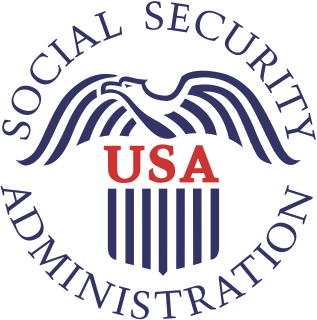
The Children's Health Insurance Program (CHIP) – formerly known as the State Children's Health Insurance Program (SCHIP) – is a program administered by the United States Department of Health and Human Services that provides matching funds to states for health insurance to families with children. The program was designed to cover uninsured children in families with incomes that are modest but too high to qualify for Medicaid.
Dr. Dynasaur is a publicly funded healthcare program in the U.S. state of Vermont, created in 1989. Vermont had an estimated 140,000 people under age 18 (90,000 under 300% above the Federal Poverty Level. Dr. Dynasaur covered 56,000 of these uninsured. After adding the coverage of this program to those already covered by private health insurance, Vermont had achieved a virtually universal health insurance for children. As a result, the state was regarded as having the best healthcare program in the United States.

Long-term care (LTC) is a variety of services which help meet both the medical and non-medical needs of people with a chronic illness or disability who cannot care for themselves for long periods. Long term care is focused on individualized and coordinated services that promote independence, maximize patients' quality of life, and meet patients' needs over a period of time.
The California Medical Assistance Program is California's Medicaid program serving low-income individuals, including families, seniors, persons with disabilities, children in foster care, pregnant women, and childless adults with incomes below 138% of federal poverty level. Benefits include ambulatory patient services, emergency services, hospitalization, maternity and newborn care, mental health and substance use disorder treatment, dental (Denti-Cal), vision, and long term care and supports. Approximately 13.3 million people were enrolled in Medi-Cal as of January 2018, or about one-third of California's population; in Tulare County and Merced County, more than 50% of county residents were enrolled as of September 2015.
Immigrant health care in the United States is distinct from citizen health care given the context of various social and economic factors as well as implemented health policies. Consequently, in addition to managing the physical and emotional strains of making a cultural transition, immigrant families find themselves in an increasingly hostile social and political environment.
BadgerCare Plus, known informally as BadgerCare, is a public healthcare coverage program for low-income Wisconsin residents created by former governor Tommy Thompson and modified by former governor Jim Doyle. The Wisconsin Department of Health Services oversees the program's implementation.
Federal Medical Assistance Percentages (FMAP) are the percentage rates used to determine the matching funds rate allocated annually to certain medical and social service programs in the United States of America. FMAP eligible programs are joint federal-state partnerships between the federal government of the United States and state governments, which are administered by the states. Thus, FMAP is an example of administration of federal assistance in the United States.
Early and Periodic Screening, Diagnostic and Treatment (EPSDT) is the child health component of Medicaid. Federal statutes and regulations state that children under age 21 who are enrolled in Medicaid are entitled to EPSDT benefits and that States must cover a broad array of preventive and treatment services. Unlike private insurance, EPSDT is designed to address problems early, ameliorate conditions, and intervene as early as possible. For the 25 million children enrolled in Medicaid and entitled to EPSDT in 2012, the program is a vital source of coverage and a means to improve the health and well-being of beneficiaries.
Health insurance in the United States is any program that helps pay for medical expenses, whether through privately purchased insurance, social insurance, or a social welfare program funded by the government. Synonyms for this usage include "health coverage", "health care coverage", and "health benefits". In a more technical sense, the term "health insurance "is used to describe any form of insurance providing protection against the costs of medical services. This usage includes private insurance and social insurance programs such as Medicare, which pools resources and spreads the financial risk associated with major medical expenses across the entire population to protect everyone, as well as social welfare programs like Medicaid and the Children's Health Insurance Program, which both provide assistance to people who cannot afford health coverage.
Healthcare reform in the United States has a long history. Reforms have often been proposed but have rarely been accomplished. In 2010, landmark reform was passed through two federal statutes enacted in 2010: the Patient Protection and Affordable Care Act (PPACA), signed March 23, 2010, and the Health Care and Education Reconciliation Act of 2010, which amended the PPACA and became law on March 30, 2010.

Health insurance coverage in the United States is provided by several public and private sources. During 2016, the U.S. population overall was approximately 325 million, with 53 million people 65 years of age and over, covered by the federal Medicare program. The 272 million non-institutional people under age 65 either obtained their coverage from employer-based or non-employer based sources, or were uninsured. Approximately 15 million military personnel received coverage through the Veteran's Administration and Military Health System. During the year 2016, 91.2% of Americans had health insurance coverage. Despite being among the top world economic powers, the US remains the sole industrialized nation in the world without universal health care coverage.
Amerigroup is a United States health insurance and managed health care provider. Amerigroup covers 7.7 million seniors, people with disabilities, low-income families and other state and federally sponsored beneficiaries, and federal employees in 26 states, making it the nation’s largest provider of health care for public programs.
The Title X Family Planning Program, officially known as Public Law 91-572 or "Population Research and Voluntary Family Planning Programs", was enacted under President Richard Nixon in 1970 as part of the Public Health Service Act. Title X is the only federal grant program dedicated solely to providing individuals with comprehensive family planning and related preventive health services. Title X is legally designed to prioritize the needs of low-income families or uninsured people who might not otherwise have access to these health care services. These services are provided to low-income and uninsured individuals at reduced or no cost. Its overall purpose is to promote positive birth outcomes and healthy families by allowing individuals to decide the number and spacing of their children.

Social programs in the United States are welfare subsidies designed to meet needs of the American population. Federal and state welfare programs include cash assistance, healthcare and medical provisions, food assistance, housing subsidies, energy and utilities subsidies, education and childcare assistance, and subsidies and assistance for other basic services. Private provisions from employers, either mandated by policy or voluntary, also provide similar social welfare benefits.

The Patient Protection and Affordable Care Act (PPACA), often shortened to the Affordable Care Act (ACA) or nicknamed Obamacare, is a United States federal statute enacted by the 111th United States Congress and signed into law by President Barack Obama on March 23, 2010. Together with the Health Care and Education Reconciliation Act of 2010 amendment, it represents the U.S. healthcare system's most significant regulatory overhaul and expansion of coverage since the passage of Medicare and Medicaid in 1965.

Kool Smiles is a dental services provider, based in the United States. Its headquarters are in the Kool Smiles Patient Support Center in Marietta, Georgia, U.S., in Greater Atlanta and has over 100 offices located across sixteen states.
Welfare in California consists of federal welfare programs—which are often at least partially administered by state and county agencies—and several independent programs, which are usually administered by the counties.
Following the signing of the Children’s Health Insurance Program (CHIP) into law on August 5, 1997 as Title XXI of the Social Security Act, Utah started looking at how to implement the Federal program under the Center for Medicare and Medicaid Services.
Health care finance in the United States discusses how Americans obtain and pay for their healthcare, and why U.S. healthcare costs are the highest in the world based on various measures.








